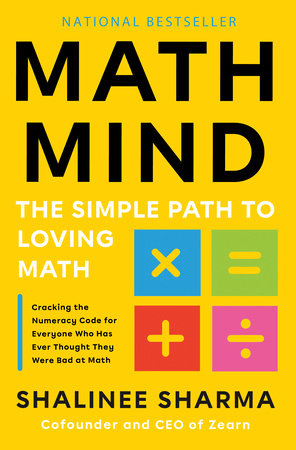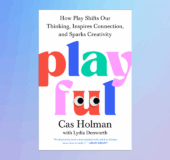Shalinee Sharma is one of the world’s top experts on math learning, but when she was in school, she sat in the back row, unsure if she could ever master the subject. Many of us buy into the idea that some people are innately good at math and others just won’t ever succeed at it—but it’s not true, and numeracy is as important as literacy when it comes to opening doors in life.
Sharma shows how complex problem solving and puzzle solving, abstract and logical thinking, developing fluency with numbers, and cultivating persistence in math are crucial skills for success that can be taught to everyone and how math, far from being a dry, dull exercise, shares common ground with art and creativity. She also debunks the myths that prevent us from learning and enjoying math, with chapters dedicated to the three roadblocks that discourage adults and kids from learning.
Math matters for everyone, but we act as if it matters only for a select few. Our education system is built around both overt and quiet classifying of students—what I have referred to as sorting. We track classes, placing the “math whizzes” in advanced courses, the “slower” kids in classes with euphemistic names: introductory, basic, general. We administer diagnostics that tell students through their scores and subsequent work what we think of their abilities. Those who are taken off the fast track don’t “go at their own pace”; instead, they never really get to learn at all.
While I know that no administrators or teachers intend to communicate to children that they’re math dunces, the teaching and learning system we have designed sends them that message anyway. They’re chastised for doing the problem the wrong way, confusing them further. If they draw pictures, they are told not to. They come to believe that because they can’t solve a problem quickly, the problem isn’t for them. There is someone else who can solve it in under a minute, so why try?
Ultimately, children don’t have to be told they’re bad at math; they tell themselves. They sort themselves out based on the accumulation of negative messages they’ve received. Further, the sorting system is so crushing, even for those who get sorted into the math pile, that we extinguish their curiosity for math altogether.
That’s the bad news.
The good news is that we can all be math people if we change the goal of instruction from sorting to teaching. We came up with this system; we can design a better one.
To move toward widespread numeracy, we need to undo the work that built these systems. Nearly everything about the way we teach math still rests on this foundation. Although I have spent more than a decade turning myself away from the sorting mindset and actions, I still catch myself stumbling into it.
Rebuilding math instruction around teaching everyone is the only way to create a critical mass of math-proficient people to solve the world’s problems. When I view my job from a teaching perspective, I ask a couple of crucial questions to assess what we’re doing when we teach mathematics: Why do I believe this? Why am I choosing this course of action? Does this rest on math success being about sorting or about learning?
Renounce the Myths and Embrace the Methods
The first step is to be vigilant about renouncing the myths of math instruction. These beliefs are the mechanisms and justifications of sorting. They’re why children learn to hate math and learn that math hates them back. The experience of being sorted, or worse, humiliated, under these premises is what extinguishes math curiosity.
To renounce the myths, you need to state the opposite realities, as follows:
Speed isn’t everything. Automaticity—the ability to call upon key facts and skills quickly and reflexively—is vital in math. When we have automaticity or fluency of math facts and procedures, we free up working memory to apply to the hard math problem in front of us. Timed activities help build up this capability.
But speed kills . . . fun and creativity. If you know an engineer, a programmer, or a scientist, ask them about how long it took them to figure out a recent work problem. I guarantee they’ll tell you that they spent days, weeks, months, and even years working out solutions. Speed is only one essential tool in math learning to provide a specific benefit, and overemphasizing it leads to neglecting the others—reducing rigor and increasing math anxiety.
Speed gets emphasized because it’s such a lazy tool for sorting. Making math a series of sprints makes it easy to declare winners and losers. Even worse, it ends up convincing students to sort themselves, on the belief that the whole field of math learning is only for the fastest seven-and eight-year-olds in basic addition and multiplication.
As we have seen, more-advanced math students (such as graduate students in physics) move more slowly through problem-solving than less-advanced math students (say, undergrads with one course in physics). They’ve learned to see more in the problems to pay attention to. Overemphasizing speed also makes math boring. Doing fast math becomes like practicing scales on the piano without ever playing a melody.
Tricks are not the answer. Math is a set of axioms or rules of the universe that you can trust completely. But we often teach it as a set of arbitrary-seeming, unconnected tricks. When you memorize tricks to solve problems, you are robbed of the intrinsic joy that comes from solving a puzzle, everything clicking into place. Even worse, memorizing tricks causes critical thinking skills to atrophy. Instead of sharpening your intuition and reasoning, you default to hacks.
Algorithms are not tricks. The standard addition algorithm always works whether you are adding two-digit numbers or ten-digit numbers, whereas the “bow tie method” for adding fractions will let you down quickly once you move beyond two addends. Tricks expire, making math something you can’t trust. Algorithms always work. Because they always work, algorithms have a clear internal logic. Teaching math as a set of tricks—even presenting algorithms as tricks to execute rather than processes to understand—prevents students from having the chance to see that logic. It assumes math is too difficult for them, and sorts out the majority of students into a pile of people who can’t be expected to understand what’s on the board.
There is no single way. You’ve been conditioned to believe that there is one correct or proper way to solve a problem. Reject this conditioning. Be open-minded and exploratory rather than single-minded and reactive when faced with a math problem. Consider the difference between answer-getting and problem-solving. Answer-getting is when math is taught as a rigid set of steps to follow. Students suspend intuition, creativity, and understanding to follow the steps. When they do get the answer, they often aren’t sure if it’s right or wrong; they have no number sense about the problem. They go through the process disempowered, with no chance to understand. Answer-getting doesn’t allow you to explore other ways of solving the problem or prepare you for real-world problem-solving.
Problem-solving is a creative cognitive process in which you strive to deepen your understanding. There are many ways to solve a problem, and they usually require visualizing it. In real-world STEM contexts, engineers discuss many ways of attacking a problem before they even begin their work. Their goal may be to find a more elegant, cheaper, or faster approach. The myth that there’s a single way to solve a math problem keeps people from ever experiencing this process. It’s another sorting and self-sorting mechanism, in which students aren’t given the chance to use their inborn ability to think mathematically.
My experiences at Zearn have convinced me that we have a social and moral obligation to move from sorting to teaching. To do this, after we’ve learned what not to believe about math, we need to understand what to do about it. Though we are still learning how to teach math collectively, we now know enough methods to improve our teaching efficacy. These are the methods that build problem-solving ability and spark interest—reviving mathematical curiosity when it has been suppressed, or, for our youngest children who haven’t run the gauntlet of self-sorting, fueling that curiosity from the beginning.
These are some methods we can use to achieve this goal, and I’d also like to share how these methods can help take us from a sorting to a teaching approach:
Know you belong. When the math classroom is inclusive, fostering a sense of belonging, kids don’t automatically classify themselves as the have-nots. Students need to feel belonging frequently in math, especially when the learning becomes challenging. As we ask students to push through each new challenge, they need the scaffold of belonging.
Use pictures and objects. Objects and math pictures give concrete meaning to deep mathematical ideas, for kids and adults alike. When you present math strictly in terms of numerals and symbols, most concepts don’t make intuitive sense. The kids who can’t get them are sorted out.
Using pictures and objects as well as abstract symbols allows us to understand as well as compute efficiently. Explaining math using representations as well as abstract language is not only for elementary school. It must be a part of learning each time we encounter a new challenge, even as adults. If we really want to stop sorting and start promoting widespread understanding, then using pictures and objects, as well as abstract symbols, must be a part of both the core math block and the extended times such as tutoring or summer school.
Make an easier problem. No one should have to give you permission to make a problem easier—it ought to be treated as common sense. Students who succeed at math often have been taught to make easier problems. They have been given permission to go rogue, while students who come to mistrust math have been forbidden to do it. Making an easier problem does not mean shortchanging the learning. Exploring other ways to solve a problem builds and hones problem-solving skills.
Try a different way. If kids think there’s only one way to solve a problem, and that way doesn’t work for them, they automatically assume it’s over, and nothing else will work. “Something is wrong with me,” they think. “I can’t do math.”
That is the voice of sorting that they hear, echoing from the educational system, from families, from all of us. We assume the worst, too; we take them out of the grade-level math they are working on and drop them to lower levels to reduce their struggle, thinking we can catch them up on some earlier learning they left unfinished. As a result, they are now behind on the new learning. If we keep doing this, they will be perpetually playing catch-up (and never succeeding).
We’ve found that students who are steered back to remedial, lower-level math problems stay behind their peers and show less improvement when they return to the topics they had originally struggled with. The solution is to help children catch up and move forward in their math learning when they first start to struggle, by bringing the targeted support to their grade-level work. But to make this change in math learning, it requires us to stop thinking of problems as a yes-or-no sorting device and start thinking of them as learning opportunities.
Practice with purpose. Endless drills lack immediate purpose or benefit. Kids learn to hate them, and from there to hate math itself. We don’t ask children to do this in other subject areas. Not only does practice without purpose dull their motivation, it increases the speed with which children sort themselves out of math.
We hold on to the idea that math learning has to be rationed even as the means and opportunities to learn keep proliferating. Education technology has increased our abundance—overwhelming, disappointing, and delighting us. Videos and apps to learn and practice practically anything are but a few clicks away.
Educators need to demand tools that complement their teaching, that reignite curiosity for math learning, and that build students’ problem-solving capacity rather than enabling rote practice. One of the few silver linings to the dark cloud that pandemic disruptions cast over learning was this: Educators have begun to demand more from education technology. Part of these demands include an insistence that technology break the paradigm of sorting in math education.
Copyright © 2024 by Shalinee Sharma. All rights reserved. No part of this excerpt may be reproduced or reprinted without permission in writing from the publisher.
Shalinee Sharma is a math expert and the CEO and cofounder of Zearn, a nonprofit educational organization behind the top-rated math-learning platform used by one in four elementary-school students and by one million middle-school students nationwide. In addition to her role at Zearn, she serves on the Braven board of directors, is a Pahara-Aspen Fellow, and serves as cochair of the Brown University Advisory Council for the College. She has a master of business administration from Harvard Business School and a Bachelor of Arts from Brown University. A child of refugees, Sharma is passionate about universal access to an excellent education.






